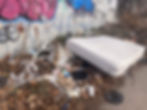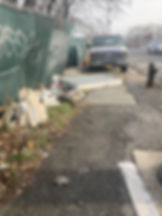Illegal dumping in the Bronx isn’t just ugly – it’s a health hazard
- ycastmediagroup
- Dec 22, 2022
- 5 min read
Updated: May 5

By Yesenia Barrios
Youthcast Media Group®
On a cold Sunday afternoon, Mike Cintron is sweeping the sidewalk in front of his home on Rosedale Avenue in the Bronx. The wind has scattered garbage from piles of wastepaper, household trash, broken furniture and used electronics that had been dumped in alleys and on street curbs and sidewalks throughout the neighborhood.
For Cintron and his Bronx neighbors, this is nothing new. Throughout New York City’s five boroughs, illegal dumping – the unauthorized public disposal of large amounts of garbage by homeowners and businesses – is a chronic issue. Some neighborhoods suffer more than others. The Bronx and Brooklyn record the highest numbers of dumping complaints, according to The City.
The reasons people illegally dump vary, according to the city Department of Sanitation, but lack of education about how to properly dispose of some items is a factor. Depending on the material, such as construction debris, homeowners and businesses might be required to hire a private trash removal company, and many do not want to pay.
William Rivera, Bronx Community Board 9 district manager, says the problem has gotten worse over the past few years.
“Illegal dumping has been happening for years,” says Rivera. “It’s been increasingly more difficult because of the (limited) resources that Sanitation and the New York Police Department have for quality of life.”
Rivera estimates that in the last year there has been a 30% to 40% increase in illegal dumping in District 9, with the neighborhoods of Soundview and Castle Hill seeing a significant increase. According to records provided by the Sanitation Department, District 9 had the second highest number of illegal dumping complaints, after district 12 in 2021, with 93 and 207 complaints, respectively.

In 2021, 5,951 “dirty conditions” complaints were made to 311, a citizen hotline used to report non-emergency problems in the Bronx. Of these, 923 were related to illegal dumping, according to Sanitation Department records. Budget cuts in fall 2020 that reduced garbage collection from twice to once a week in some neighborhoods of the Bronx appears to have exacerbated the problem.
Adding to the problem: The Bronx is a natural target for both homegrown dumpers and dumpers from other boroughs, even nearby suburbs. Major arteries, including I-95, I-87, Bruckner Boulevard and the Cross Bronx Expressway, run through dozens of Bronx neighborhoods. Residents say that this makes illegal dumping easy for anyone with access to a truck or car.
Residents report that motorists leave garbage along the shoulders of these highways, or on sidewalks, streets, in backyards, empty lots and parks. Officers of the NYPD’s Transit District 12 say they have found refuse dumped next to their Morris Park Avenue headquarters.
“It’s not healthy for people,” says Magdalena Olivio, who lives in the Bronx’s Parkchester neighborhood. She said she called the Sanitation Department multiple times to complain about illegal dumping and request removal of garbage. The mess gets picked up, but a few days later there is a new pile, she says.
Not just a quality of life issue
Illegal dumping is not just a quality of life issue. It also can cause serious health problems. From 2009 to 2019, the Bronx was ranked the unhealthiest county in the state of New York by the Robert Wood Johnson Foundation and University of Wisconsin Population Health Institute’s County Health Rankings and Roadmaps. Though the report does not measure illegal dumping, it does take into account environmental factors, such as cramped housing and air pollution and their negative impact on health.
Garbage can also spread disease. Bacteria, insects and vermin thrive in uncollected garbage and can make their way into people’s homes. Rats can carry as many as 35 diseases including Hantavirus Pulmonary Syndrome, Salmonellosis and rat-bite fever. Rats are also host to ticks and fleas which can transmit diseases such as Lyme disease and typhus.
A wide range of health risks are directly and indirectly related to illegal dumping, says Markus Hilpert, associate professor of environmental health sciences at Columbia University.
The health risks from inhaling or ingesting toxic chemicals from garbage can vary from a mild infection to cancer, Hilpert says. “You also have cardiovascular diseases leading to elevated blood pressure, heart attack/strokes depending on the chemical to which you are exposed. You can also have respiratory diseases,” he adds.
As garbage breaks down, it can release volatile organic compounds, which are gases that are dangerous to breathe, as well as chemicals that pose a danger if touched. Liquids and gases can also seep into and remain in the soil, surface water and air, increasing the long-term health risks.

Dumping electronics such as televisions, computers and toys with batteries, as well as construction debris can be particularly harmful, says Hilpert. This kind of waste can contain toxic materials such as arsenic, lead, cadmium and asbestos.
While illegal dumping is a health hazard to all, experts say that children, the elderly and people with pre-existing health conditions are the most vulnerable. Children are particularly vulnerable because their brains and bodies are still developing and if exposed to harmful chemicals, the damage can be more severe and long-lasting, Hilpert says.
“Thinking of the soil, there would also be a risk to children playing and touching the soil, so there could be ingestion exposure through hand to mouth exposure,” he says.
Stepping up enforcement
In recent years, some steps have been taken to address the problem. In 2018, the Sanitation Department launched a program aimed at discouraging the practice.
However, the number of citizen complaints increased. In 2019, there were 2,814 complaints about improper disposal in New York City. In 2020, the number increased to 3,770, and as of August 2021, there were 2,316 complaints.
Now, four years later, the city is trying a different approach: In the summer of 2021, the city launched a pilot program to step up enforcement of illegal dumping in the Bronx and Brooklyn, says Belinda Mager, a spokesperson for the Sanitation Department. The department issued summonses for illegal dumping and other related offenses, impounded vehicles and made one arrest, she says.
No data is yet available to measure the pilot’s success.
Residents acknowledge the city’s efforts but say more needs to be done. Cintron says he’d like to see the Sanitation Department focus on landlords and property owners who encourage dumping by failing to keep their property clean and garbage free.
“If sanitation enforcement and the city was holding [landlords] accountable, maybe they’d be more attentive to cleaning their property,” says Cintron.

Hector Hernandez, who works in the Hunts Point neighborhood, supports efforts at tougher enforcement. Hernandez says he has seen illegal dumping for many years, and believes city officials need to confront those responsible and hold them accountable.
He also suggests forming a city-led task force to monitor the problem until dumping is reduced. “They should have another force, another outlet or group that can just pick up garbage,” says Hernandez.
A solution as simple as adding – and servicing – more public garbage bins may be worth trying, according to some residents. That is a solution, Hernandez, Citron and Rivera say, that appears to have been tried and is working in other parts of the city.
So why not the Bronx?
“The Bronx is always neglected – that is nothing new,” says Hernandez.
Yesenia Barrios, a graduate of Baruch College in New York City, is a former intern with Youthcast Media Group®
